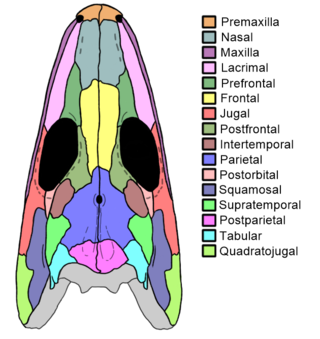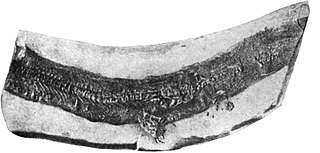
Reptiliomorpha is a clade containing the amniotes and those tetrapods that share a more recent common ancestor with amniotes than with living amphibians (lissamphibians). It was defined by Michel Laurin (2001) and Vallin and Laurin (2004) as the largest clade that includes Homo sapiens, but not Ascaphus truei. Laurin and Reisz (2020) defined Pan-Amniota as the largest total clade containing Homo sapiens, but not Pipa pipa, Caecilia tentaculata, and Siren lacertina.

Anthracosauria is an order of extinct reptile-like amphibians that flourished during the Carboniferous and early Permian periods, although precisely which species are included depends on one's definition of the taxon. "Anthracosauria" is sometimes used to refer to all tetrapods more closely related to amniotes such as reptiles, mammals, and birds, than to lissamphibians such as frogs and salamanders. An equivalent term to this definition would be Reptiliomorpha. Anthracosauria has also been used to refer to a smaller group of large, crocodilian-like aquatic tetrapods also known as embolomeres.

Joggins is a rural community located in western Cumberland County, Nova Scotia, Canada. On July 7, 2008 a 15-km length of the coast constituting the Joggins Fossil Cliffs was officially inscribed on the World Heritage List.

Hylonomus is an extinct genus of reptile that lived 312 million years ago during the Late Carboniferous period. It is the earliest unquestionable reptile. The only species is the type species Hylonomus lyelli. Despite being amongst the oldest known reptiles, it is not the most primitive member of the group, being a eureptile more derived than either parareptiles or captorhinids.

Archaeothyris is an extinct genus of ophiacodontid synapsid that lived during the Late Carboniferous and is known from Nova Scotia. Dated to 306 million years ago, Archaeothyris, along with a more poorly known synapsid called Echinerpeton, are the oldest undisputed synapsids known. The name means ancient window (Greek), and refers to the opening in the skull, the temporal fenestra, which indicates this is an early synapsid. Protoclepsydrops also from Nova Scotia is slightly older but is known by very fragmentary materials.
Protoclepsydrops is an extinct genus of early synapsids, found in Joggins, Nova Scotia. The name means 'first Clepsydrops', and refers to it being the predecessor of the other early synapsid Clepsydrops.

Proterogyrinus is an extinct genus of early tetrapods from the order Embolomeri. Fossil remains of Proterogyrinus have been found in Scotland, UK, and West Virginia, United States, and date back to the Serpukhovian, which is from about 331 to 323 million years ago. The genus was originally named by renowned vertebrate paleontologist Alfred Sherwood Romer in 1970. A comprehensive redescription was later published by Canadian paleontologist Robert Holmes in 1984. The generic name "Proterogyrinus" is Greek for "earlier wanderer" or "earlier tadpole". This name was chosen by Romer in keeping with a trend of naming long-bodied early tetrapods with the suffix "-gyrinus".

Microsauria is an extinct, possibly polyphyletic order of tetrapods from the late Carboniferous and early Permian periods. It is the most diverse and species-rich group of lepospondyls. Recently, Microsauria has been considered paraphyletic, as several other non-microsaur lepospondyl groups such as Lysorophia seem to be nested in it. Microsauria is now commonly used as a collective term for the grade of lepospondyls that were originally classified as members of Microsauria.

Dendrerpeton is a genus of an extinct group of temnospondyl amphibians. Its fossils have been found primarily in the Joggins Formation of Eastern Canada and in Ireland. It lived during the Carboniferous and is said to be around 309–316 million years of age, corresponding to more specifically the Westphalian (stage) age. Of terrestrial temnospondyl amphibians evolution, it represents the first stage. Although multiple species have been proposed, the species unanimously recognized is D. acadianum. This species name comes from “Acadia” which is a historical name for the Nova Scotia region as a French colony. It refers to the location of the coal field at which the fossil was found.

Embolomeri is an order of tetrapods or stem-tetrapods, possibly members of Reptiliomorpha. Embolomeres first evolved in the Early Carboniferous (Mississippian) Period and were the largest and most successful predatory tetrapods of the Late Carboniferous (Pennsylvanian) Period. They were specialized semiaquatic predators with long bodies for eel-like undulatory swimming. Embolomeres are characterized by their vertebral centra, which are formed by two cylindrical segments, the pleurocentrum at the rear and intercentrum at the front. These segments are equal in size. Most other tetrapods have pleurocentra and intercentra which are drastically different in size and shape.

Anthracosaurus is an extinct genus of embolomere, a possible distant relative of reptiles that lived during the Late Carboniferous in what is now Scotland, England, and Ohio. It was a large, aquatic eel-like predator. It has a robust skull about 40 centimetres (1.3 ft) in length with large teeth in the jaws and on the roof of the mouth. Anthracosaurus probably inhabited swamps, rivers and lakes. Its name is Greek for "coal lizard".

The Allegheny Group, often termed the Allegheny Formation, is a Pennsylvanian-age geological unit in the Appalachian Plateau. It is a major coal-bearing unit in the eastern United States, extending through western and central Pennsylvania, western Maryland and West Virginia, and southeastern Ohio. Fossils of fishes such as Bandringa are known from the Kittaning Formation, which is part of the Allegheny Group.

Asaphestera is an extinct genus of a tetrapod described on the basis of fossils from the Carboniferous of the Joggins locality in Nova Scotia, Canada. It was originally described as an undetermined lepospondyl and subsequently classified as a microsaur within the family Tuditanidae. A study published in May 2020 found that specimens referred to Asaphestera represented several unrelated species. Steen (1934)'s original species name Asaphestera platyris was retained for a skull which has been re-evaluated as the earliest known synapsid.

Tuditanomorpha is a suborder of microsaur tetrapods. Tuditanomorphs lived from the Late Carboniferous to the Early Permian and are known from North America and Europe. Tuditanomorphs have a similar pattern of bones in the skull roof. Tuditanomorphs display considerable variability, especially in body size, proportions, dentition, and presacral vertebral count. Currently there are four families of tuditanomorphs, with two being monotypic. Tuditanids first appear in the Lower Pennsylvanian. Goniorhynchidae, Hapsidopareiidae, and Trihecatontidae appear in the Late Pennsylvanian and Early Permian.
Spondylerpeton is an extinct genus of embolomere closely related to "Cricotus" (Archeria) in the family Archeriidae. This genus is known from fragmentary remains, namely a short series of tail vertebrae preserved in an ironstone nodule. These remains were found in the Mazon Creek beds of Illinois, an area famed for its preservation of Carboniferous plants and animals. Spondylerpeton individuals were probably about three to four feet in length, by far the largest animals known to have inhabited the Mazon Creek area during this era.
Hylerpeton is an extinct genus of microsaurian tetrapods belonging to the family Gymnarthridae from the late Carboniferous period.

Andersonerpeton is an extinct genus of aïstopod from the Bashkirian of Nova Scotia, Canada. It is known from a single jaw, which shares an unusual combination of features from both other aistopods and from stem-tetrapod tetrapodomorph fish. As a result, Andersonerpeton is significant for supporting a new classification scheme which states that aistopods evolved much earlier than previously expected. The genus contains a single species, A. longidentatum, which was previously believed to have been a species of the microsaur Hylerpeton.
Carbonoherpeton is an extinct genus of embolomere which lived in the Pennsylvanian of Nova Scotia, Canada.
Palaeoherpeton is an extinct genus of eogyrinid embolomere which lived in the Pennsylvanian of Scotland. It is primarily known from a series of relatively small but well-preserved skulls. Some of these have among the best braincase and middle ear material known in embolomeres. Originally given the species name Palaeogyrinus decorus, this was later corrected to Palaeoherpeton decorum when it was determined that Palaeogyrinus was a name preoccupied by a genus of beetles.

Ichthyerpeton is an extinct genus of stegocephalian ("tetrapod") from the Pennsylvanian of Ireland. It was originally described by E.P. Wright and Thomas Henry Huxley in 1866, based on an articulated partial skeleton from the Jarrow coal seam in County Kilkenny. It was redescribed in 2021 by Aodhán Ó Gogáin and Patrick N. Wyse Jackson, who used X-ray tomography to peer through the dense coating of scales which obscures many bones. The body was very elongated, with tall diplospondylous vertebrae similar to those of embolomeres. The fossil includes a stout hindlimb with distinct digits and a proportionally short tibia. Though previously considered an embolomere, colosteid, or long-bodied temnospondyl, Ichthyerpeton has a unique combination of features which prevents an unambiguous placement among these tetrapod groups.





















